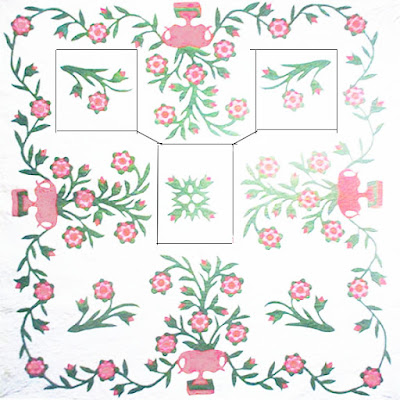Looking for a clever set for next year's applique BOM atmy Civil War Quilts blog page I came across this quilt thatlooks to be 1840-1880, pictured in the 1981 Quilt Engagement Calendar.The border vases and vine dominate, breaking big the rule thatborders are the supporting actors.
It definitely has possibilities as a Block of the Month set. I posted a similar quilt on my Facebook page and Kay Triplett noted that their Quilt & Textile Collections hold an almost identical quilt.Same vase on a platform---a rather quirky addition.Inscribed "1864 for Emma from Mother"And here's a third from the ebay seller GB-Best in Pennsylvania.You can tell the quilts apart by subtle differences in florals and spacing between images. Kay recalled a similar quilt in Mary Koval's inventory but we couldn't find a photo.There are not many quilts in the giant border files. One more related:The Art Institute of Chicago owns this one attributed to Sarah J. Harden,which they date as 1857. No more information.The giant vases are set in similar fashion.Here's a guess as to setting. You would want to work on thatcenter block and get it where it should be. (A little larger wouldn't hurt, either.)These do seem to have some connection to this extremely popular border design.74" x 68"Quilt documented by the New York project in Ithaca.This common border tends to be a strong visual but not enormous in proportion.The vase also standing on a rectangle here.Another version. The platform is not common.Xenia Cord published a paper on this last border. See Xenia E. Cord, "Vessel, Vine, and Floral Quilt Borders." Uncoverings 2018Kay's comparison of motifsWhence such similar quilts with dominant borders? Kay's has no inscription but the GB Best quilt says, "For Emma from Mother. "Seems like if a mother was doing these for all her children, they would have all been labeled similarly," writes Kay. She has a point. I lately try to get away from the idea of identical quilts being made for family members and consider the professional quiltmaker. Was it a woman creating similar quilts for her children or a business woman making a popular design for her customers?
Working on the photo I noticed a single peacock perched in a flowering tree. I also saw the quilt is inked "October 26, 1858.”UPDATE
Xenia Cord sends another example with block variations:
"The Peacock, between page 132 and 133, in Florence Peto, Historic Quilts (New York: The American Historical Company, Inc., 1939.) The text for the image, on page 122, says the quilt is inked Thomas W. Nable of Claysville, Pa., owned by Mrs. Paul Sturdevant. Peto likens the design to peacock-like 'implications' and is probably responsible for the name of the design. Note that this one has 4 flowers on each of the smaller floating motifs. Too bad the image is in black and white."
The 2022 BOM at CivilWarQuilts begins in March. Freedom's Friends tells the story of the Underground Railroad in Philadelphia as told through William Still's records.
https://civilwarquilts.blogspot.com/

















I do love this setting, but it might be a bit too ambitious for me this year. Looking forward to Freedom's Friends in March.
ReplyDeleteLooking at the pedestals at the start of this blog I notice the wrong perspective, just like what my mother, an untrained artist did when she took an art class for the first time. This was designed by someone who is not a natural artist. The back of the pedestal is wider when it should be narrower.
ReplyDelete